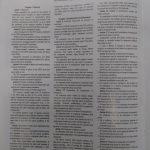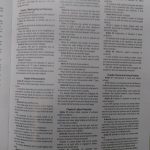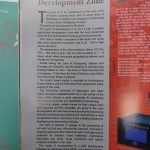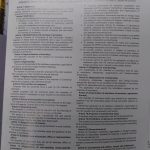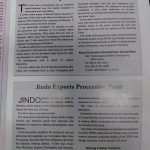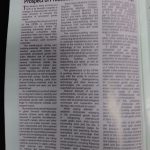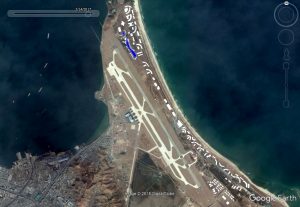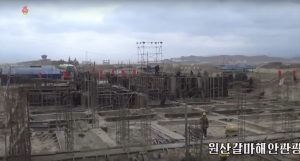Benjamin Katzeff Silberstein
In this post, I’ll be collecting news and information on Moon Jae-in’s plans and ideas for economic development in North Korea. I’ve had to take a little break from blogging for the past couple of weeks due to travel, so the articles here won’t necessarily be recent or up-to-date, especially since up-to-date regarding the Korean peninsula these days seems to extend only to the last five minutes or so.
For the contents of the Panmunjom Declaration that have to do with the North Korean economy, feel free to check out this post, where I make the case (which still holds, I would argue) for why infrastructure is the most plainly obvious as of now for economic cooperation with North Korea in the wake of the latest warming of ties.
Infrastructure was an important component of the famed USB-stick that Moon handed to Kim at the first inter-Korean summit this year. Hankyoreh:
South President Moon Jae-in ordered a joint inter-Korean research effort to examine future economic cooperation ahead of the anticipated lifting of international sanctions against North Korea following an upcoming North Korea-US summit, which will follow up the inter-Korean summit that was held on Apr. 27.
Speaking on Apr. 30 at the first Blue House senior secretaries’ and aides’ meeting since the inter-Korean summit, President Moon said he “look[ed] forward to us being able to carry out a joint inter-Korean research effort for implementation of the Oct. 4 Summit Declaration [of 2007] and inter-Korean economic cooperation,” a key Blue House official reported.“He was saying we need joint research to examine what kinds of economic cooperation the South and North can engage in ahead of [sanctions against North Korea] being lifted,” the official explained.
During their summit, President Moon also personally gave North Korean leader Kim Jong-un a pamphlet on his “new economic vision” and a USB device containing a presentation video, the Blue House reported.
The materials reportedly contained details on power plant construction and other economic cooperation measures that could be implemented once inter-Korean relations gain momentum and sanctions against North Korea are lifted.During the Apr. 30 meeting, President Moon described the Panmunjeom Declaration as “a peace declaration proclaiming to the world that there will be no more threat of war or nuclear weapons on the Korean Peninsula.”
Article source:
South Korean President Moon Jae-in orders joint research effort for inter-Korean economic cooperation
Seong Yeon-cheol
Hankyoreh
2018-05-01
New York Times noted the somewhat ironic fact that Kim received Moon’s plan on a USB-stick, an item whose use by its own citizens the North Korean regime has long cracked down on:
For years, Kim Jong-un, North Korea’s leader, has been cracking down on USB flash drives that activists smuggle into his isolated country to poison his people’s minds with outside influences, like South Korean K-pop music.
But last month, when he met with the South’s president, Moon Jae-in, Mr. Moon handed him a USB drive that contained quite a different message.
In charts and video clips, Mr. Moon’s memory stick laid out a “new economic map for the Korean Peninsula,” including new railways and power plants for the impoverished North, should Mr. Kim abandon his nuclear weapons, according to South Korean officials.
Mr. Moon based his sales pitch on the belief that Mr. Kim wants to become the North Korean equivalent of Deng Xiaoping, who oversaw the economic liberalization of China. In this view, Mr. Kim may be willing to transform his pariah state by trading in his nuclear arsenal for diplomatic and economic incentives he needs to achieve prosperity.
[…]
“Kim Jong-un’s desire to develop his country’s economy is as strong as, and even stronger than, his desire for nuclear weapons,” said Lee Jong-seok, a former unification minister of South Korea. “But he knows he cannot achieve the kind of rapid economic growth in China that he envisions for his country while keeping his nuclear weapons — because of the sanctions.”
[…]
Vilified as he was, however, Mr. Kim has also shown signs of being a reformer, granting farms and factories more autonomy, allowing more markets to open, and setting off a building boom in his showcase capital, Pyongyang. He exhorts his country to follow “international development trends” and “global standards” and even admits failing to deliver on his promise that his long-suffering people would “no longer have to tighten their belts.”
“My desires were burning all the time, but I spent the past year feeling anxious and remorseful for the lack of my ability,” Mr. Kim said in a nationally broadcast speech last year, a startling admission for a member of the family that has ruled North Korea with the help of a personality cult since its founding in 1948.
After meeting him, Mr. Moon called Mr. Kim “open-minded and practical.”
Nowhere is Mr. Kim’s dilemma better seen than in his policy of “byungjin,” or parallel advance, which seeks a nuclear arsenal and economic development simultaneously. Under that policy, Mr. Kim has rapidly developed his country’s nuclear weapons and ballistic missile programs, arguing that a nuclear deterrent would make his country feel secure enough to focus on rebuilding the economy. But the world has responded by imposing crippling sanctions.
[…]
If Mr. Kim pursues the route of economic reform, energy and transportation are the two areas where he most needs outside help. In his meeting with Mr. Moon, Mr. Kim admitted to the “embarrassing” condition of his roads and railways, South Korean officials said.
Trains running on electricity remain North Korea’s main means of transport, carrying 90 percent of its cargo and 60 percent of its passenger traffic, according to Ahn Byung-min, a senior analyst at the South’s government-funded Korea Transport Institute. But its rail systems are so decrepit that its fastest train, which runs to the Chinese border from Pyongyang, travels at 28 miles an hour. Other trains run at less than half that speed, Mr. Ahn said.
Lacking cash for oil imports, North Korea produces all its electricity from hydroelectric dams and coal-burning power plants. But the country’s power industry is trapped in a vicious cycle, energy experts say. Chronic electricity shortages make it difficult to produce coal and transport it to power plants. People in search of firewood for heat and cooking have denuded their hills, causing floods and droughts and making silt pile up at dams. That cuts down hydroelectric generation.
North Korea’s electricity generation amounts to only 4.4 percent of South Korea’s, according to Park Eun-jeong, an analyst at the South’s Korea Development Bank. The country prioritizes supplying electricity to lighting statues of Mr. Kim’s father and grandfather, who had ruled before him, while passengers wait for hours in trains unable to move because of power shortages, according to defectors from the country.
“Electricity is the Achilles’ heel for North Korea,” said Lee Jong-heon, an energy analyst in Seoul.
Mr. Moon’s proposal to modernize the North’s roads and railways and link them to the South’s is not meant to help just North Korea.
South Korean policymakers say that the two Koreas must first integrate their economies to make an eventual reunification less chaotic. They also envision building trans-Korean railways to find faster and cheaper routes to export South Korean goods to China, Russia and Europe, and bring Russian oil and gas into the South through pipelines for its power-hungry economy.
Full article and source:
South Korea Hands Kim Jong-un a Path to Prosperity on a USB Drive
Choe Sang-hun
New York Times
2018-05-10
Moon’s plan consists of three “economic belts”, as South China Morning Post notes, with infrastructure links that carry great potential gains for China and Russia as well:
President Moon Jae-in gave the North’s leader Kim Jong-un a USB drive containing a “New Economic Map of the Korean Peninsula” at the fortified border village of Panmunjom on April 27.
The initiative included three economic belts – one connecting the west coast of the peninsula to China, making the region a centre of logistics; one connecting the east coast to Russia for energy cooperation and one on the current border to promote tourism.
Whilst sources at the South Korean presidential office did not give further details about the information contained in the drive, they confirmed that the plan was in line with Moon’s “Berlin speech” last year when he outlined his basic approach to the north on a visit to the German capital.
During last year’s presidential election campaign, Moon pledged to merge the two Koreas’ economies in a single market to lay the foundations for unification.
Park Byeong-seug, a South Korean lawmaker from Moon’s ruling Democratic Party of Korea, said the proposal was in line with Moon’s campaign promises.
“The concept of the three belts was one of President Moon’s pledges during the election last year,” Park said.
“The new economic map includes railway links between the two Koreas and China’s northeast stretching all the way to Europe.”
One part of the plan would involve the construction of a rail link starting in Mokpo on the southwest tip of the peninsula, passing through Seoul and Pyongyang and the North’s Special Administrative Region of Sinuiju, before reaching Beijing.
Beijing is likely to welcome Seoul’s proposal as it accords with the core Chinese national interest of enhancing sustainable economic development and boosting the country’s northeastern rust belt.
Cheng Xiaohe, a deputy director at the centre for international strategic studies at Renmin University said Beijing may try to incorporate the plan into its Belt and Road Initiative.
“The northeast has been China’s weakest link and seen poor economic development for years. A rail link could make a real difference to the region,” Cheng said.
Improving the area’s logistics would also benefit China as its access to the open seas in that part of the world is physically blocked by the Korean peninsula and Russia’s far east.
North Korea’s economy is also closely tied to the northeast of China and opening up the reclusive state’s markets could provide new opportunities for the Chinese provinces on its border.
Lu Chao, a research fellow at Liaoning Academy of Social Sciences, said: “The plan would have a huge impact on China’s northeastern region as it would transform the region as a centre of logistics in East Asia, which could function as a driving force for the rapid economic growth of the region.”
“The northeast is the region with the greatest economic potential in China. A railway connection would bring a myriad of investments from overseas and would help the economy take off.”
[…]
South Korea would have to allow its allies and the UN to mediate any easing of sanctions before it could establish any economic cooperation with the North.
Moon Chung-in, a special foreign affairs and national security adviser in Seoul, said last month that Seoul’s economic incentives would compensate Pyongyang for freezing its missile programme, disclosing its nuclear capacity and allowing international inspections within its borders.
Full article and source:
Seoul offers Kim Jong-un grand bargain to link North and South Korean economies with China
Lee Jeong-ho
South China Morning Post
2018-05-07
Not surprisingly, Hyundai Asan is hoping to get in on whatever action may come. CNN:
Hyundai Group said Tuesday [May 8th] that it’s setting up a task force to prepare for the potential restarting of economic projects in North Korea.
The announcement comes shortly after a historic summit between South Korean President Moon Jae-in and North Korean supreme leader Kim Jong Un at which they committed themselves to rebuilding ties after years of tensions.
Hyundai Group, which split from the Hyundai Motor Group in 2000, was involved in various business projects in North Korea in the past, including a mountain resort and the Kaesong industrial complex, where North Korean workers made goods for South Korean companies.
“Hyundai needs to be ready when/if the two Koreas agree on terms and inter-Korean economic cooperation resumes,” a company spokesman said.
Hyundai will be closely monitoring the planned summit between Kim and US President Donald Trump that’s expected to take place in the coming weeks, as well as any potential changes to the heavy sanctions in place on North Korea’s economy, the spokesman said.
The Kaesong complex, a symbol of cooperation between the two Koreas, was closed as relations deteriorated in 2016. More than 120 South Korean companies had a presence there, employing tens of thousands of North Koreans and providing a steady stream of foreign currency to the regime in Pyongyang.
Hyundai also previously operated a tourist resort at North Korea’s Mount Kumgang, near the border with South Korea. It was shut down in 2008 after a South Korean tourist was killed by a North Korean soldier.
The company’s ties to North Korea go back to Hyundai’s late founder, Chung Ju-young, who was born there.
Last week, South Korean Deputy Prime Minister Kim Dong-yeon said the country’s government was “considering various scenarios” for economic cooperation between the two Koreas.
“The government is preparing response plans to different scenarios in terms of how and how fast to pursue [economic cooperation] and how to procure the resources for it,” he said.
South Korea’s government has allocated about $900 million to fund economic projects that involve both countries this year, according to the minister.
Full article and source:
Hyundai Group is getting ready to do business in North Korea again
Daniel Shane
CNN
2018-05-08
To be sure, preparations and planning are well underway in Seoul. Reuters:
South Korea’s finance minister said on Wednesday [May 2nd] the government was discussing how to finance possible economic projects with North Korea, although any projects with Pyongyang must first be approved by the international community.
“We’re internally carrying out preparations, in terms of what to prepare, and how to cooperate with the international community, and how to finance (possible inter-Korea projects),” Kim Dong-yeon told reporters in Sejong.
“But we need support from the international community and need to watch the (upcoming) summit between the United States and North Korea,” Kim said, without elaborating on specifics of any government financing.
Kim’s comments come after South Korean President Moon Jae-in and his North Korean counterpart Kim Jong Un agreed last Friday on a common goal of a “nuclear free” peninsula, and to “adopt practical steps towards the connection and modernization of the railways and roads”.
Many speculate that the two Koreas will start joint infrastructure projects as soon as international sanctions on North Korea are lifted. Currently, North Korea is under sanctions imposed by the U.N. Security Council to stop its nuclear weapons and missiles programs.
Kim also said there was a rise in the number of Chinese tourists in March although the services sector has not yet recovered from a drop in such visitors due to tensions between the two countries.
“The number of Chinese tourists is noticeably increasing since March, although it hasn’t recovered to the pre-Thaad level,” Kim said.
Tourist numbers plunged last year after South Korea angered China by deploying a U.S. Terminal High Altitude Area Defence (THAAD) system that features radar which Beijing believes could be used to penetrate its territory.
Full article and source:
South Korea considers financing of possible inter-Korea projects: finance minister
Reuters
2018-05-02
To be continued and updated…

